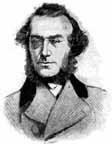Cartoonist, caricaturist, and illustrator famous for his work for Punch, Leech was educated at Charterhouse, and then studied medicine, but turned to art. From 1841 he contributed hundreds of sketches of middle-class life and political cartoons to Punch, as well as to the Illustrated London News (1843 onward) and Once a Week (1859-62). He illustrated several books, including Dickens's A Christmas Carol (1843) and the sporting novels of R. S. Surtees.

John Leech, the son of a coffee house proprietor, was born in London on 29 August, 1817. He was educated at Charterhouse, while W. M. Thackeray was still a student there, and at the age of sixteen he went to St. Bartholomew's Hospital to study medicine. Leech's teachers soon became aware of Leech's superb anatomical drawings and began commissioning him to paint portraits. He was one of the artists considered to replace Robert Seymour for The Pickwick Papers (1836-37) and, although not selected, Leech left medical school and in order to make a living from drawing and painting. His first known published work was a pamphlet called Etchings and Sketchings, By A Pen, Esq. (1835), which included drawings of street characters such as cabmen, policemen, and street musicians — the very sort of people who inhabit the early Sketches by Boz. Over the next few years he produced a series of humourous pamphlets including the Comic Latin Grammar, The Fiddle-Faddle Fashion Book and The Children of Mobility. His work during this early period also included illustrations for the magazine Bell's Life in London. Although influenced by the satirical work of James Gillray and George Cruikshank, Leech's humour was as one critic pointed out "less grotesque, less boisterous, less exaggerated, nearer to the truth and to ordinary experience."
In 1840 Leech was employed by the London Magazine to supply illustrations. The following year he was recruited by a new journal of humour, founded by Mark Lemon and Henry Mayhew. Leech's comic drawings proved extremely popular, and were one of the main reasons why the new magazine, Punch, became such a great success. Over the next twenty-three years Punch; or, The London Charivari published some 3,000 of Leech's drawings and 600 cartoons. J. A. Hammerton (1910) notes that "Leech was a great attraction of Punch in those days, and his unrivalled power of graphic humour largely contributed to the successful founding of that unique journal" (14). A significant percentage of Leech's drawings dealt with political issues. Like the editors of the magazine, Lemon and Mayhew, Leech held fairly radical views. Between 1842 and 1845 Leech produced a series of cartoons such as Cheap Clothing and The Agricultural Question, which are critical of the dubious morality of the capitalist system. In the cartoon Mr. Punch's Big Cut, Cartoon, No. I: Substance and Shadow (1843), often regarded as the world's first political cartoon, Leech by implication criticized contemporary artists for ignoring social issues such as poverty. One may assume that his depiction of Ignorance and Want in A Christmas Carol (1843) is a graphic exemplar of how the artist with a social conscience may address such issues.
Related material
Bibliography
Spartacus Educational article on Leech.
Hammerton, J. A. The Dickens Picture-Book: A Record of the Dickens Illustrators. The Charles Dickens Library, vol. 18. London: Educational Book Co., 1910.
Leech, John. Mr. Punch's Big Cut, Cartoon, No. I: Substance and Shadow. Punch; or, The London Charivari. Vol. 5. 15 July 1843, p. 23.
Last modified 10 May 2014